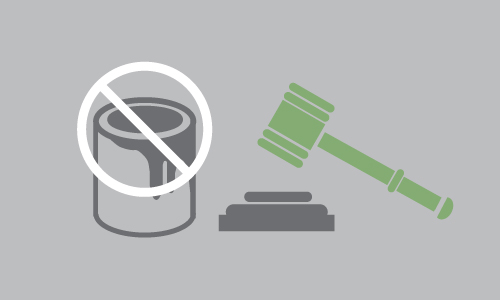It may be odd to think that a state can charge a manufacturer for anything ranging from product liability to global warming prevention using a very loose interpretation of a law often used to fine people for unkept lawns or running an illegal gambling ring, but there’s currently a dangerous trend that could set dangerous precedent for everyone in the manufacturing community.
Continued Scrutiny on the Manufacturing Community
In a recent blog, we discussed that there is increased focus on manufacturing emissions, due in part to the consolidation taking place between some of the global players in paint and coatings.
However, the scrutiny doesn’t stop at one industry; activists, class action lawyers, and media outlets have kept a keen eye on the entire sector. Of course, this has only ramped up in recent years in today’s world of clickbait and partisanship, as we discussed in a recent blog:
“There’s money to be made in breaking a story, and a relatively innocuous violation of an EPA regulation could go from “EPA Press Release” to the front page of every newspaper, environmental blog, and class action lawyer’s website. Additionally, in today’s hyperpartisan environmental reporting world, EPA/CAA noncompliance by an industry giant could easily be spun into a PR nightmare on par with the DuPont chemical leak.”
Manufacturers play a vital role in the community; they have continued to reduce emissions, playing by the rules set by regulators and municipalities, often going above and beyond legal requirements to protect employees and local residents. VOC emissions in the United States continue to drop as technologies improve destruction efficiency while making it more affordable to minimize environmental impact.
Even though these organizations work hard to keep in compliance with laws and regulations, they still face judgement in many states including New York, Connecticut, Colorado, Washington, California, and others that have begun to use “public nuisance” laws as a club. Many of these cases have been rejected, but some have recently found their way through the court system.
Public Nuisance Lawsuits: “Misguided” Yet Costly Attacks on American Manufacturing
While manufacturers work to do right by their community and comply with regulations, cities and states have turned vague interpretations of public nuisance laws to impose their will on manufacturers.
A recent article by Professor Richard Epstein, one of the nation’s most respected authority on tort law and Senior Fellow at Stanford University’s Hoover Institution took a look at this practice used against manufacturers. These suits have been filed against manufacturers in a wide range of industries to address everything from product liability to global warming to indirect stormwater contamination, calling these cases “especially dubious.”
Basics of Nuisance Laws
Nuisance laws refer to “legal actions to redress harm arising from the use of one’s property.” Divided into public and private nuisance, these two laws complement each other. Private nuisances require at a minimum “an invasion of another’s interest in the private use and enjoyment of land. The defendant must release, emit, or discharge the offensive materials—such as filth, odors, or noise—onto the plaintiff’s property. The relevant causal connection has to be so tight that there are no intervening forces between the discharge and the ensuing physical invasion of the plaintiff’s property.
Public nuisance refers to criminal action and covers a wide variety of minor crimes that threaten the health, morals, safety, comfort, convenience, or welfare of a community.
A Slippery Slope
Nuisance laws do hold value, and have been used for minor offenses for centuries (millennia if you include the first documented pollution lawsuit over ‘cheese smoke’ in the Second Century AD).
However, as noted by the Manufacturers’ Center for Legal Action, public nuisance claims against manufacturers are staggering, unwarranted, and overbroad, validating a dangerous new form of tort liability. By turning the public nuisance doctrine into a “catch-all” tort for social and environmental issues, every manufacturer in the United States could be at risk.
Conclusion: Nuisance Claims May be a Nuisance, but CAA Violations Are Still Very Real
While it’s unlikely that one of the many nuisance claims will hold up in the highest court, it’s important to know that in this highly polarizing time, manufacturers need to be highly attentive to the things that they can control and for which they can be legitimately held accountable. The egregious use of nuisance doctrine is a brief trend in legal activism that—while currently a nuisance for certain manufacturers—is unlikely to continue.
EPA enforcement, however, is much more straightforward, and emissions standards are much easier to follow. That said, a CAA violation is not only costly but also damaging to your reputation; media outlets and class action lawyers will jump at any chance to claim that you are ‘poisoning’ the community.
The truth is, manufacturers continue to work hard to reduce emissions and their environmental impact and have made huge strides in both compliance and innovation. Even if this is true however, manufacturers need to remain vigilant about their emissions.
Learn More: The CMM Group Guide to VOC Abatement
If your VOC abatement solution is pushing or has exceeded 20 or even 30 years of existence, it’s not only inefficient (costly) by today’s standards, it’s risky to your reputation, your compliance efforts, and the environment.
Learn more about the steps you need to take to control VOC emissions by reading our recent whitepapers, The CMM Group Guide to Volatile Organic Compound (VOC) Abatement and VOC Abatement Guide for Paint and Coatings Manufacturers, we would like to invite you to download this immensely helpful resource for understanding the battlefield that is pollution and learning ways to control VOC output. We have provided the first three pages of the guide below, and welcome you to download the entire guide here.




